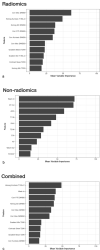Magnetic resonance radiomic feature performance in pulmonary nodule classification and impact of segmentation variability on radiomics
- PMID: 36367095
- PMCID: PMC9733623
- DOI: 10.1259/bjr.20220230
Magnetic resonance radiomic feature performance in pulmonary nodule classification and impact of segmentation variability on radiomics
Abstract
Objective: Investigate the performance of multiparametric MRI radiomic features, alone or combined with current standard-of-care methods, for pulmonary nodule classification. Assess the impact of segmentation variability on feature reproducibility and reliability.
Methods: Radiomic features were extracted from 74 pulmonary nodules of 68 patients who underwent nodule resection or biopsy after MRI exam. The MRI features were compared with histopathology and conventional quantitative imaging values (maximum standardized uptake value [SUVmax] and mean Hounsfield unit [HU]) to determine whether MRI radiomic features can differentiate types of nodules and associate with SUVmax and HU using Wilcoxon rank sum test and linear regression. Diagnostic performance of features and four machine learning (ML) models were evaluated with area under the receiver operating characteristic curve (AUC) and 95% confidence intervals (CIs). Concordance correlation coefficient (CCC) assessed the segmentation variation impact on feature reproducibility and reliability.
Results: Elevn diffusion-weighted features distinguished malignant from benign nodules (adjusted p < 0.05, AUC: 0.73-0.81). No features differentiated cancer types. Sixty-seven multiparametric features associated with mean CT HU and 14 correlated with SUVmax. All significant MRI features outperformed traditional imaging parameters (SUVmax, mean HU, apparent diffusion coefficient [ADC], T1, T2, dynamic contrast-enhanced imaging values) in distinguishing malignant from benign nodules with some achieving statistical significance (p < 0.05). Adding ADC and smoking history improved feature performance. Machine learning models demonstrated strong performance in nodule classification, with extreme gradient boosting (XGBoost) having the highest discrimination (AUC = 0.83, CI=[0.727, 0.932]). We found good to excellent inter- and intrareader feature reproducibility and reliability (CCC≥0.80).
Conclusion: Eleven MRI radiomic features differentiated malignant from benign lung nodules, outperforming traditional quantitative methods. MRI radiomic ML models demonstrated good nodule classification performances with XGBoost superior to three others. There was good to excellent inter- and intrareader feature reproducibility and reliability.
Advances in knowledge: Our study identified MRI radiomic features that successfully differentiated malignant from benign lung nodules and demonstrated high performance of our MR radiomic feature-based ML models for nodule classification. These new findings could help further establish thoracic MRI as a non-invasive and radiation-free alternative to standard practice for pulmonary nodule assessment.
Figures







Similar articles
-
Can MRI contribute to pulmonary nodule analysis?J Magn Reson Imaging. 2019 Jun;49(7):e256-e264. doi: 10.1002/jmri.26587. Epub 2018 Dec 21. J Magn Reson Imaging. 2019. PMID: 30575193
-
[Value of radiomics models based on MRI diffusion weighted imaging and apparent diffusion coefficient in differentiating benign and malignant thyroid nodules].Zhonghua Yi Xue Za Zhi. 2023 Nov 7;103(41):3279-3286. doi: 10.3760/cma.j.cn112137-20230913-00453. Zhonghua Yi Xue Za Zhi. 2023. PMID: 37926572 Chinese.
-
Physics-Informed Discretization for Reproducible and Robust Radiomic Feature Extraction Using Quantitative MRI.Invest Radiol. 2024 May 1;59(5):359-371. doi: 10.1097/RLI.0000000000001026. Epub 2023 Oct 9. Invest Radiol. 2024. PMID: 37812483 Free PMC article.
-
Enhancing the Clinical Utility of Radiomics: Addressing the Challenges of Repeatability and Reproducibility in CT and MRI.Diagnostics (Basel). 2024 Aug 22;14(16):1835. doi: 10.3390/diagnostics14161835. Diagnostics (Basel). 2024. PMID: 39202322 Free PMC article. Review.
-
Magnetic resonance imaging (MRI) radiomics in paediatric neuro-oncology: A systematic review of clinical applications, feature interpretation, and biological insights in the characterisation and management of childhood brain tumours.Digit Health. 2025 Apr 22;11:20552076251336285. doi: 10.1177/20552076251336285. eCollection 2025 Jan-Dec. Digit Health. 2025. PMID: 40297347 Free PMC article. Review.
Cited by
-
Differentiating inflammatory and malignant pulmonary lesions on 3T lung MRI with radiomics of apparent diffusion coefficient maps and T2w derived radiomic feature maps.J Thorac Dis. 2024 May 31;16(5):2875-2893. doi: 10.21037/jtd-23-1456. Epub 2024 May 24. J Thorac Dis. 2024. PMID: 38883623 Free PMC article.
-
Quantitative analysis of chest MRI images for benign malignant diagnosis of pulmonary solid nodules.Front Oncol. 2023 Aug 4;13:1212608. doi: 10.3389/fonc.2023.1212608. eCollection 2023. Front Oncol. 2023. PMID: 37601669 Free PMC article.
-
Evaluation of Pulmonary Nodules by Radiologists vs. Radiomics in Stand-Alone and Complementary CT and MRI.Diagnostics (Basel). 2024 Feb 23;14(5):483. doi: 10.3390/diagnostics14050483. Diagnostics (Basel). 2024. PMID: 38472955 Free PMC article.
-
Diffusion-Weighted MRI: Potential Tool for Pulmonary Nodule Characterization.Indian J Radiol Imaging. 2023 Nov 23;34(1):1-2. doi: 10.1055/s-0043-1776884. eCollection 2024 Jan. Indian J Radiol Imaging. 2023. PMID: 38106875 Free PMC article. No abstract available.
-
MRI-based clinical-radiomics nomogram to predict early neurological deterioration in isolated acute pontine infarction: a two-center study in Northeast China.BMC Neurol. 2024 Jan 23;24(1):39. doi: 10.1186/s12883-024-03533-2. BMC Neurol. 2024. PMID: 38263044 Free PMC article.
References
-
- Common Cancer Types NIH . National Cancer Institutie . Available from : https://www.cancer.gov/types/common-cancers
MeSH terms
LinkOut - more resources
Full Text Sources
Medical

